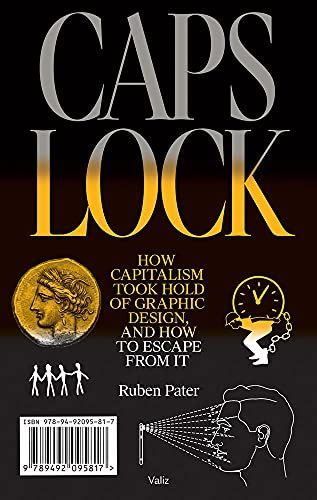
Caps Lock How Capitalism Took Hold of Graphic Design, and How to Escape from It
Capitalism could not exist without the coins, banknotes, documents, information graphics, interfaces, branding, and advertisements made by graphic designers. Even anti-consumerist strategies such as social design and speculative design are appropriated to serve economic growth. It seems design is locked in a cycle of exploitation and extraction, furthering inequality and environmental collapse. CAPS LOCK uses clear language and visual examples to show how graphic design and capitalism are inextricably linked. The book features designed objects and also examines how the study, work, and professional practice of designers support the market economy. Six radical design cooperatives are featured that resist capitalist thinking in their own way, hoping to inspire a more socially aware graphic design.
Reviews
Seyfeddin Başsaraç@seyfeddin
Karolina@fox
taylor miles hopkins@bibette
Isabella Chiara Vicco @isabellachiarav
Krystal@demonhour
Eric L. H.@eric
Morgen Ruff@morgen__ruff
Joasia Fidler-Wieruszewska@fidlerowna
Inês Pinto@ines
Ines Perez@inesvhperez
Erin Peace@erinpeace
Eleni Agapis@agapisev
Juan Felipe@jfcr
Danilo Campos@daniloc
Olivier Estévez@olivier
James Madson@jamesmadson
Highlights
Krystal@demonhour
Krystal@demonhour
Krystal@demonhour
Krystal@demonhour
Krystal@demonhour
Joasia Fidler-Wieruszewska@fidlerowna
Joasia Fidler-Wieruszewska@fidlerowna
Joasia Fidler-Wieruszewska@fidlerowna
Joasia Fidler-Wieruszewska@fidlerowna
Joasia Fidler-Wieruszewska@fidlerowna
Joasia Fidler-Wieruszewska@fidlerowna
Joasia Fidler-Wieruszewska@fidlerowna
Joasia Fidler-Wieruszewska@fidlerowna
Joasia Fidler-Wieruszewska@fidlerowna
Joasia Fidler-Wieruszewska@fidlerowna
Joasia Fidler-Wieruszewska@fidlerowna
Joasia Fidler-Wieruszewska@fidlerowna
Joasia Fidler-Wieruszewska@fidlerowna
Joasia Fidler-Wieruszewska@fidlerowna
Joasia Fidler-Wieruszewska@fidlerowna
Joasia Fidler-Wieruszewska@fidlerowna
taylor miles hopkins@bibette
Page 200
taylor miles hopkins@bibette
Page 191
taylor miles hopkins@bibette
Page 183